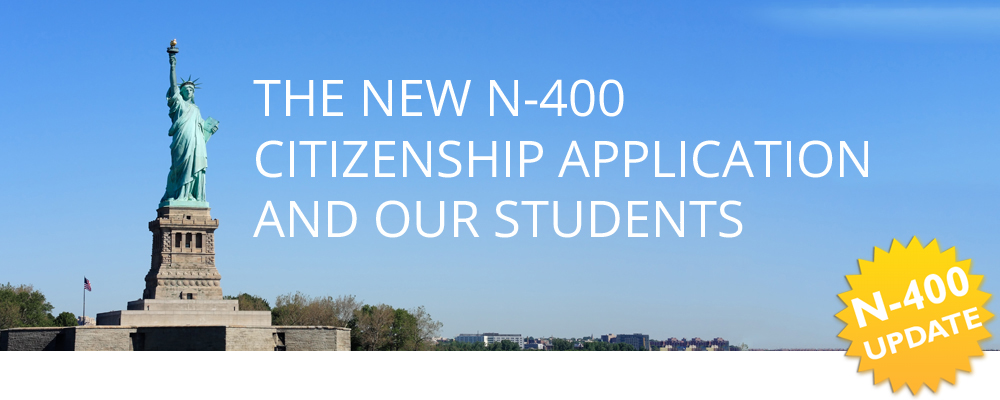


Bill Bliss
As of May 5, 2014, the new N-400 form is required for all applications for U.S. citizenship. The form is longer than the previous one, it adds to the personal information required about marital status and children, it asks several more questions to comply with recent federal legislation related to terrorism and child soldiers, and it therefore has some important implications for the instruction we offer our students who are preparing for their naturalization interview and citizenship exam. Since a USCIS officer evaluates an applicant’s English speaking ability during the course of the interview, and since the interview focuses on verifying information on the N-400 form, it’s important for our students to be prepared to explain the information they have provided.
(An important note: Eligibility requirements for citizenship have not changed, and the requirements to demonstrate knowledge of U.S. history, government, and civics have not changed. Only the application form itself has changed, which therefore has implications for the language our students may need to talk about their application during the interview.)
A Longer Form, but Not as Long As It Seems
The new Form N-400 from the U.S. Citizenship and Immigration Service (USCIS) runs 21 pages, while the old form was just ten. However, it hasn’t really doubled in size. A lot of empty space at the bottom of each page is devoted to a 2D bar code that allows USCIS to scan the form information directly into its system. (The new form is a fillable PDF document, and applicants are encouraged to fill out the form electronically online and then print it out, sign, and mail. Applicants can also print out the blank form and fill it in by hand, but completing it electronically will reduce the chance of errors and improve the processing time.)
Some Easy Modified Questions
A few modified questions on the new form require some slightly more challenging vocabulary and information. The terms marital status, spouse, divorced, and widowed have been added to the personal information questions. Also, while the old form asks about an applicant’s children, the new form asks about each child’s relationship to the applicant—so the terms biological child, stepchild, and legally adopted child are now important for students to know. The new form also asks for information about the spouse’s employer.
One improvement in the new form is the merger of previously separate questions about work and education. Applicants can now list their work and education activities chronologically in a single listing that covers the previous five years. Similar to in a job interview, they should be prepared to talk about their chronology of jobs and schools and to probably do so in reverse order, with the most recent activity first. Of course, they should also be prepared to answer any separate questions about their work or education.
Several New and Challenging Questions
The so-called “Have you ever . . . “ moral character questions that previously occupied Part 10 in the old form now reside in a very notably expanded Part 11 in the new form. This is mainly due to the Intelligence Reform and Terrorism Prevention Act (IRTPA) of 2004 and the Child Soldier Prevention Act of 2008, which have resulted in several new questions relating to national security and specific types of persecution. The new questions ask about any involvement in interfering with a person’s religious practices, hurting, torturing, killing, forced sexual relations, and genocide.
But Which Form Did My Students Use?
Since the processing times for citizenship applications can be half a year or more, the reality is that many of our current students preparing for naturalization interviews may have completed the old form rather than the new one. During these months of transition, instructors might want to ask students which form they submitted. However, it might be prudent to prepare all students to answer the new questions regardless of their form, since it is certainly possible that an officer might ask a question that involves vocabulary or information requested on the new one.
"Voices of Freedom" and the new N-400
Teachers and students using the Voices of Freedom program frequently comment that one of the most important sections is the appendix, which provides comprehensive practice with the questions students may need to answer as they talk about their citizenship application during the interview. (You can read an article about this feature of the program here.) New printings of the program will reflect the Form N-400 changes. In the meantime, if you would like an advance copy of this section, just send an email request to bill.bliss@languageandcommunication.org and type "New N-400" in the subject line.
An additional program resource is the Voices of Freedom Activity & Test Prep Workbook, which contains flash cards providing picture-based practice with key interview questions and answers, including some of the most challenging "Have you ever . . . " questions about moral character. Here's a sample. Students find the game-like practice motivating and helpful, and other workbook activities support this practice and also prepare students for the all-important reading and writing sections of the citizenship exam.
Resources
There are some excellent resources that can help you and your students prepare for the new form’s impact on the naturalization process:
A USCIS video offers an explanation of the new Form N-400
A USCIS presentation to stakeholders explains the specific form changes (This is a PDF version of a PowerPoint presentation, probably best as a resource for teachers rather than students. See especially Slides 11-14, which highlight some of the new form questions.)
Translations of the new form are available through the Catholic Legal Immigration Network, Inc. (CLINIC)
A Spanish translation is provided by CLINIC
A Chinese translation is provided by Asian Americans Advancing Justice
A Vietnamese translation is provided by the Asian Law Alliance
(The translations may be particularly helpful in explaining the meaning of the new Part 11 moral character questions.)
CLINIC has also provided an informative webinar about the new form (Also best used as a resource for teachers rather than students)
Publisher's Note:
Since its initial publication over 25 years ago, Voices of Freedom has helped hundreds of thousands of students on their path to U.S. citizenship. The new Voices of Freedom Activity & Test Prep Workbook features essential reading and writing practice for the citizenship exam, flash cards to help students master key interview questions, and practice tests.
New EL/Civics Packages integrate language instruction, civics, and basic skills to meet federal EL/Civics guidelines. Both packages include the Voices of Freedom Student book and Workbook. The Foundations EL/Civics Package (ISBN 978-0-13-324814-2) also includes the Foundations Student Book and the Word by Word Basic Picture Dictionary. The Beginning EL/Civics Package (ISBN 978-0-13-324813-5) also includes the Side by Side Plus Level 1 Student Book and the Word by Word Picture Dictionary.
